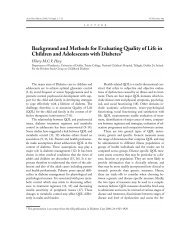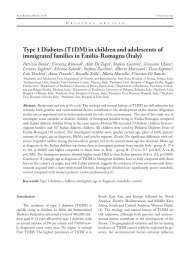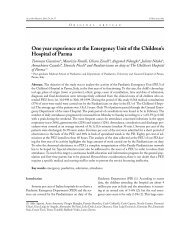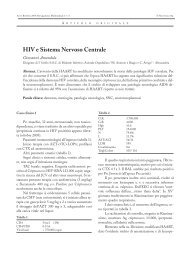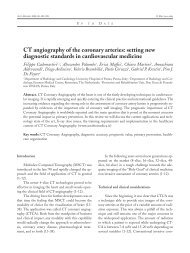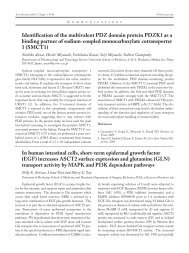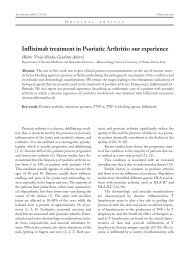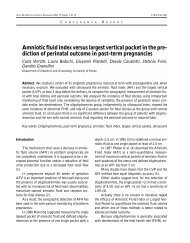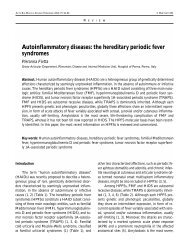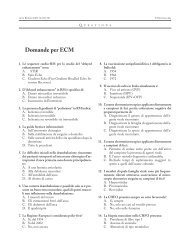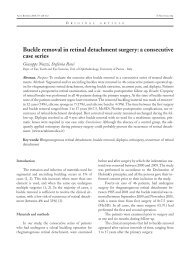Short reports+frontesp96-98 - Acta Bio Medica Atenei Parmensis
Short reports+frontesp96-98 - Acta Bio Medica Atenei Parmensis
Short reports+frontesp96-98 - Acta Bio Medica Atenei Parmensis
Create successful ePaper yourself
Turn your PDF publications into a flip-book with our unique Google optimized e-Paper software.
106 <strong>Short</strong> Reports<br />
Results: One hundred-twelve incisional hernias, 86<br />
primary (M:31; F:55; mean age 60.4±9.44 yrs; range:<br />
29-82 yrs) and 26 recurrent (M:10; F:16; mean age<br />
62.1±12.3 yrs; range: 39-85 yrs), have been treated.<br />
Overall, 37 patients were older than 65 years. Mean<br />
hospital stay was 6.7±3.4 and 6.7±3.1 days for primary<br />
and recurrent incisional hernia respectively. In the primary<br />
group were observed 11/86 (12.7%) seromas,<br />
5/86 (5.8%) hematomas and one sinus. No seroma or<br />
hematoma has been found in the ULTRAPRO®<br />
group. Recurrence rate was 3.4%. In the recurrent<br />
group, 4/26 (15.3%) seromas, 1/26 (3.8%) hematomas<br />
and 2/26 (7.6%) recurrences were observed. Discussion:<br />
The employment of synthetic meshes for the treatment<br />
of incisional hernia is, to date, a widely accepted<br />
practice. Several types of meshes, with different composition<br />
and structure (pore size, width, etc.) are now<br />
available. Ultrapro ® mesh is a composite mesh (poliglecaprone-25<br />
and polypropylene) which provides the<br />
advantage to reduce the implanted permanent mass to<br />
40%; its structure made by thinner filments creates a<br />
macroporous structure which results to be more susceptible<br />
to “tissue ingrowth”. Such mesh represents,<br />
to our opinion, a balanced compromise between rigidity<br />
which allows an easier mesh implantation, and<br />
flexibility which provides an anatomic dynamic allocation.<br />
The fixation of the mesh through a fibrin glue,<br />
furthermore, allows a quick and homogeneous adhesion<br />
of the prosthesis, so avoiding wrinkling, reducing<br />
the incidence of seromas and hematomas and the need<br />
of sutures and metal agraphes which could result, in<br />
our opinion, in a lower incidence of postoperative<br />
pain.<br />
References<br />
1. Kingsnorth A, Le Blanc K. Hernia: inguinal and incisional.<br />
Lancet 2003; 362: 1561-71.<br />
Cardiologic risk in patients over 75 years of age<br />
undergoing pulmonary resection<br />
A. Fiorello, G. Vicidomini, P. Laperuta, A. Perrone, M.<br />
Santini<br />
Department of Anesthesiology, Surgery and Emergency Medicine,<br />
Thoracic Surgery Unit, University of Naples II, Naples,<br />
Italy<br />
Aims: Cardiocirculatory function testing is a fundamental<br />
part of patient work-up prior to pulmonary<br />
resection, particularly in individuals at risk (age >75<br />
years or with cardio-respiratory deficiency). This<br />
study aimed to assess the incidence of cardiac complications<br />
in patients aged over 75. Materials and<br />
methods: In the last 5 years, 457 patients underwent<br />
pulmonary resection due to NSLC. The patients were<br />
divided into 2 groups: Group A: 280 patients aged<br />
between 65 and 75 (15.7% of the population (n=44)<br />
presenting with underlying heart disease). Group B:<br />
65 patients aged >75 years. (58.4% of the population<br />
(n=38) presenting with underlying heart disease). All<br />
the patients were examined clinically and given a basic<br />
ECG with supplementary exercise test in the case<br />
of ischemic heart disease. The electrocardiogram was<br />
performed in the patients in Group A who were candidates<br />
for a pneumonectomy, and in all the patients<br />
in Group B. patients with increased pulmonary resistance<br />
or significant coronary deficiency were subsequently<br />
given a Myocardial Scintigraphy or Angiocardio-scintigraphy.<br />
Lastly, the high cardiac risk patients<br />
with respiratory functionality were catheterized.<br />
Results: In Group A we detected 26 patients (9.2%)<br />
with arrhythmia: 18 (69.2%) atrial fibrillation (7 with<br />
previous atrial fibrillation), 5 (19.2%) atrial flutter (2<br />
with previous flutter), 3 (11.6%) extrasystole. In<br />
Group B we detected 23 patients (35.8%) with supraventricular<br />
arrhythmia: 15 (65.21%) atrial fibrillation<br />
(8 patients with previous arrhythmia), 5 (21.8%) atrial<br />
flutter (1 with previous flutter), 3 (13%) extrasystole.<br />
One patient in Group B died post-operatively due to<br />
AMI. In Group A the incidence of supraventricular<br />
arrhythmia was 68% after pneumonectomy, 18% after<br />
bilobectomy, 11% after lobectomy and 3% after atypical<br />
resection. In Group B the incidence of supraventricular<br />
arrhythmia was 58% after pneumonectomy,<br />
12% after bilobectomy, 15% after lobectomy and 15%<br />
after atypical resection. We did not detect differences<br />
in survival among the cardiac complication patients<br />
with respect to the controls. Conclusions: Atrial fibrillation<br />
was the most frequent cardiac complication; it<br />
was reversible in all patients who did not have<br />
arrhythmia prior to surgery. Important risk factors are:<br />
age, pre-operative heart disease, extent of the pulmonary<br />
resection, surgical procedure (opening of the pe-



